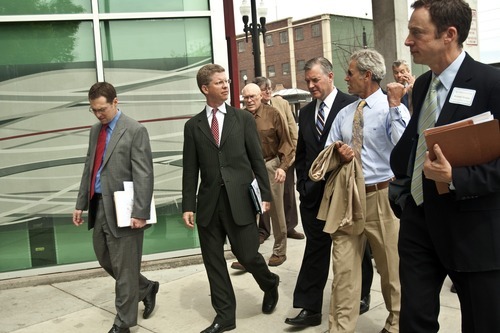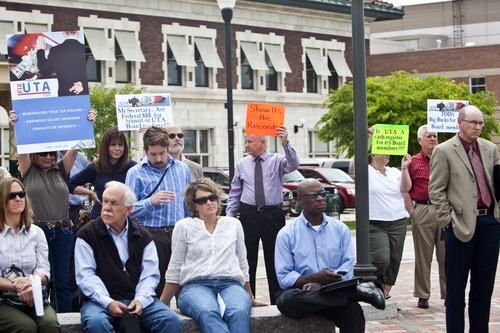This is an archived article that was published on sltrib.com in 2011, and information in the article may be outdated. It is provided only for personal research purposes and may not be reprinted.
He didn't focus on the grime or smell as he stood in front of an abandoned warehouse at 200 South and 600 West in Salt Lake City. Shaun Donovan, U.S. secretary of housing and urban development, was too busy envisioning the future there with local leaders.
They talked about how the area could soon have shops, offices and apartments attracted by the easy transit connections next door at the intermodal transportation hub. They pointed at the shiny Gateway development a few blocks away, and figured the run-down area might look pristine like that soon.
"Salt Lake City has not only been a leader, it's also been a model for the entire nation" in turning around such areas with smart planning, Donovan said a few minutes later at a celebration at the Rio Grande train station.
He and local leaders held that event to mark the beginning of implementing the "Wasatch Choice for 2040," a regional plan developed by local governments to guide future growth. The event also celebrated a recent $5 million HUD grant to assist in planning and attracting new development around mass transit stops.
"I saw with my own eyes how the $5 million we are investing … is going to help link affordable housing to jobs and transportation" and create economic growth along TRAX, FrontRunner and streetcar lines, Donovan said.
He noted that the Wasatch Front expects to add 1.4 million people in the next 30 years, a 65 percent increase. He said the only way to avoid traffic gridlock and massive pollution is with the sort of smart growth that allows more people to walk, bike or take mass transit where they need to go. He said that is what local leaders are pushing with their plans.
"We are here to celebrate the beginning of the next remarkable chapter of this vision that you have," Donovan told a group of Utah leaders including Salt Lake City Mayor Ralph Becker, Salt Lake County Mayor Peter Corroon, West Valley City Mayor Mike Winder and Lt. Gov. Greg Bell.
"Every one of you has forged a partnership that has turned this community into a national model … of connecting families to housing and more broadly to opportunity," Donovan said.
Becker said, "I imagine the secretary usually comes to places where there are sparkling new things to celebrate." He said what Donovan was shown instead was a recovering derelict area "that is primed for a remarkable redevelopment in our city" by providing transportation that will attract development.
"Our impressive, expanding transit system can be and will be the catalyst for dozens of new neighborhoods that can meet a significant portion of the demand for those new residents who will join us here by 2040," said Robert Grow, chairman of Envision Utah, a group helping to coordinate planning.
As part of the Wasatch Choice for 2040 effort, regional planning groups have just adopted plans guiding transportation projects over the next 30 years. They include some new freeways and highways, but focus more on adding such things as "bus rapid transit" where buses will have their own lanes in highways to move more people quickly.
The long-term plans call for developing transit corridors with a mix of uses — retail, offices and residences — with multiple transportation options, including transit and bike lanes. It also calls for developing town centers or station communities where people can travel short distances for their needs.
If that vision is implemented, Grow said it "will significantly reduce traffic congestion, improve our air quality, use less water and energy, protect our critical lands, and preserve the character of our existing communities."
Donovan hailed the vision, saying, "It's very, very exciting." —
Transit-oriented development
Housing and Urban Development Secretary Shaun Donovan joined local leaders to outline a vision for the future of a long-neglected area of Salt Lake City that they expect to be revitalized with residences, retail and offices, helped by the nearby transit development. The hope is that highway gridlock can be headed off as the population grows by the convenient options of walking, biking and transit in these planned new neighborhoods.







